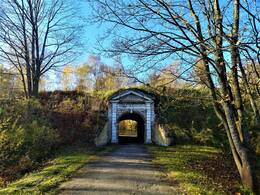The Estonian Navy assists Latvian forces during the War of Independence
On June 23, Estonians celebrate Victory Day, thus celebrating the joint Latvian-Estonian victory in the battles of Cēsis. And in this victory the Estonian navy played an important role, which in this Landeswehr war, as the Estonians call it, with its courageous actions and precise cannon fire in the mouth of the Daugava threatened the main supply routes of German forces across the Daugava in the immediate vicinity of Riga.
Towards Cēsis, with further possible movement in the north-east, towards the Iron Division and the German-Baltic Landesver, the Estonians saw a real threat to Estonia. Therefore, the Commander-in-Chief of the Estonian Army, Johann Laidoner, sent significant forces towards Cēsis, reinforcing them with armored trains. It should also be taken into account that Tallinn had a British naval base and one of the German goals was to weaken the British fleet's presence in the Baltic Sea or even to achieve its complete departure from the previously German-controlled territories.
The Commander-in-Chief of the Estonian Armed Forces, Johann Laidoner, and the Commander of the Navy, Johan Pitka, decided not to unexpectedly attack the German forces near Riga from the sea, thus supporting and assisting the Estonian and Latvian ground forces. When the Estonians informed the representative of the British Allies in Tallinn about this intention, they received the answer that it could be a big mistake that would be difficult to correct later. With intrigue behind the scenes, the British apparently hoped to move von der Goltz's military forces forward and use their interests to overthrow the Bolshevik forces in Russia. However, in the difficult political situation, the Estonians decided to implement this plan and prepared for a military operation to attack Daugavgrīva.
On June 26, 1919, an Estonian squadron set sail. It consists of the destroyer Lennuk, the cannon Lembit, the minesweepers Olev and Kalev, the cannon-armed icebreaker Tasuja, which is attached to a barge with ammunition and fuel. The naval destroyer Vambola is also expected to join these navies. On June 28, the squadron reaches the Pärnu River and throws anchors there, Vambola approaches the barge and replenishes its fuel supplies. Continuing to stay close to the shore to disguise their movement, the Estonian squadron approaches the mouth of the Gauja and throws anchors there to prepare for the attack.
Early in the morning of July 2, when ground forces are already attacking the suburbs of Riga, the cannon Lembit is ordered to enter the mouth of the Daugava and silence the German coast batteries, because at that time it is known that Estonian land units have already reached Milgravis. Lembit is chosen because it has a small draft and is able to maneuver well. When Lembit has destroyed the German coast's batteries with a precise fire, the destroyer Vambola takes part in the battle, approaching the Daugavgrīva fortress and silencing its German cannons. Estonian ships are then being attacked by two German planes, but both are being shot down with anti-aircraft weapons. The Germans flee the Daugavgrīva fortress, and the Estonians fall into the hands of the German-formed river flotilla, armed and intended for battle on the Daugava. These are river boats armed with machine guns and even small cannons. When transferring part of their crews to these ships, Estonian sailors go up the Daugava to Bolderāja and, when they open fire, occupy the German coastal battery there. The Germans resist and are destroyed, but some captured and wounded are taken to large ships in the mouth of the Daugava. For the German forces, these unexpected strikes from the sea significantly reduced their combat capabilities and threatened the supply of their army across the Daugava, they demoralized the fighting spirit and deprived them of the desire to continue the fight.
The commander of the Estonian navy, Johan Pitka, later acknowledged that this naval combat operation was one of the most successful and significant during the Estonian Landeswehr War. Miraculously, the same Estonians admit that this important battle operation at the mouth of the Daugava for the Estonians took place without losses.
It is also interesting that the Estonians also landed on the shore of Mangaļsala, whose inhabitants watched the fighting on the other bank of the Daugava from a distance of about 2 kilometers. Before the war, Estonian fishermen from their coast in Pärnu to Narva during salmon fishing, which lasted from Midsummer to Miķelis, often made a profit on this Latvian coast. And it turned out that among the Estonian soldiers there were such salmon fishermen and they met well-known Latvian fishermen in Mangaļsala, with whom they had been on fishing trips before the World War. They met again as good and old friends. And how not - if there was an end to the war.
Jūrnieks magazine
Related topics
Related objects
Daugavgrīva Fortress
Daugavgrīva Fortress (entry from Birzes street) is located on the Daugavgrīva Island where Buļļupe river joins the Daugava river. The fortress was built in the 17th century to defend from enemies moving in the direction of Riga, which was an important administrative, trade and production centre. Later it became the main fortification of the Latvian Army coastal defence with several support points. This defensive fortification system is one of the most valuable objects of Latvia's military heritage. This fortress has witnessed Latvian military history. For example, during the Crimean War (1853-1856) Latvian and Estonian gunboat crews were trained here. The main objective of these units was to protect local ports and the coast from attacks by the British navy. During World War I Daugavgrīva militiamen companies were formed here. These were the first Latvian combat units, which came even before the Latvian Riflemen. Nowadays it is possible to see the territory of the fortress. ‘Komētforts’ and the Seaside Nature Park are located nearby and Mangaļsala fortifications are on the other side of the Daugava river.





